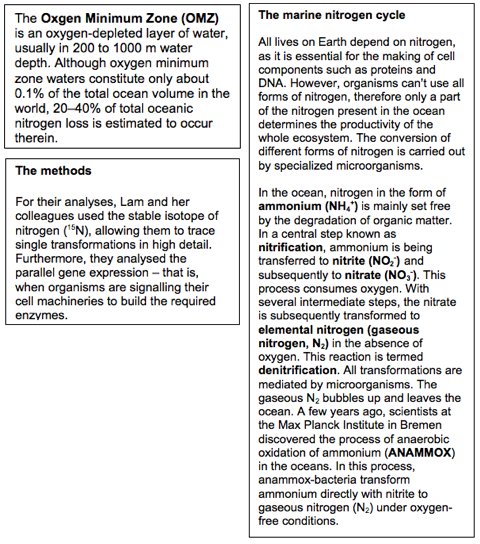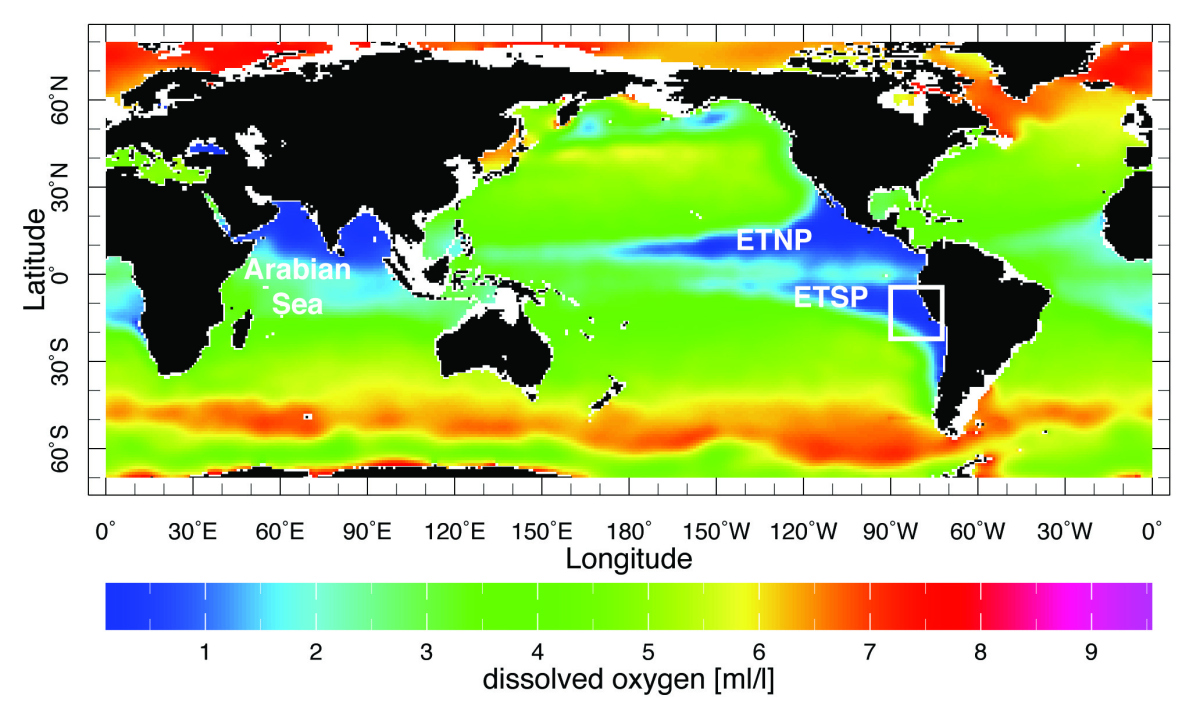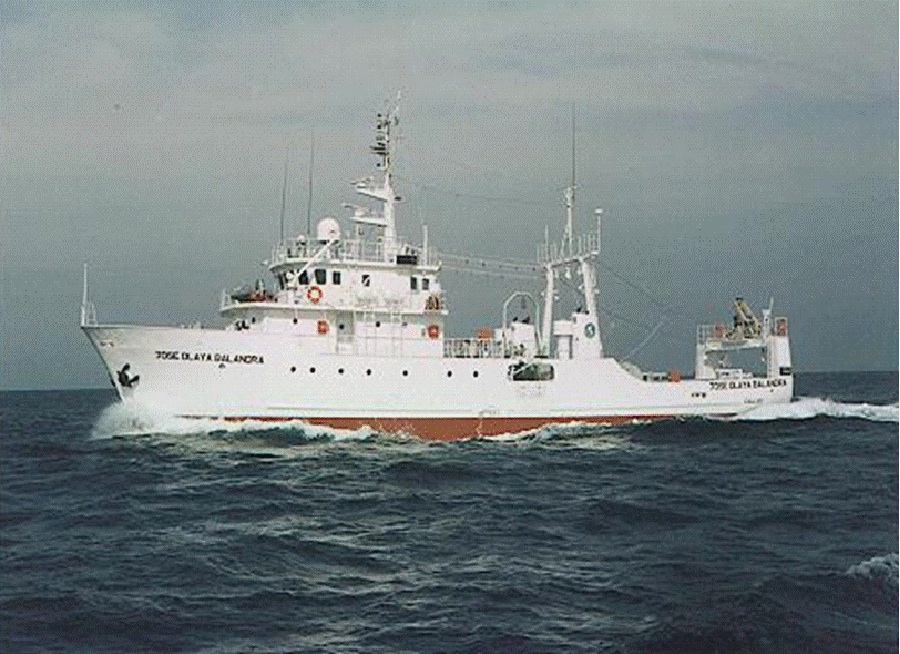Page path:
- Press Office
- Press releases 2009
- 02.03.2009 The Marine Nitrogen Cycle - Revisited
02.03.2009 The Marine Nitrogen Cycle - Revisited
Induced by global warming, regions of oxygen-poor water – so-called oxgen minimum zones – are expanding in the world’s oceans. That has significant consequences on the marine habitat and fisheries, as higher organisms avoid these regions. The global elemental cycles of carbon and nitrogen are closely linked to oxgen minimum zones. Therefore, detailed knowledge of these cycles is essential for predicting the effects of climate change on the oceans as well as possible feedback mechanisms. A study by an international group of scientists around Phyllis Lam from the Max-Planck-Institute for Marine Microbiolgy in Bremen, Germany, published in the journal “PNAS”, brings us a big step closer to this understanding.
The scientists concentrated on the nitrogen cycle of the Peruvian oxgen minimum zone in the eastern Tropical South Pacific. This region is one out of three regoins in the world’s oceans where nitrogen escapes from seawater. „For a long time, this loss was attributed to denitrification, which transforms nitrate to gaseous nitrogen, which can then escape to the atmosphere“, Lam explains. „This picture is changing: Apparently, the so-called anammox-bacteria are responsible for the major part of the lost nitrogen. However, up to now it has been unclear where the anammox-bacteria obtain their resources for this transformation.“ Moreover, the lack of denitrification strongly questions our understanding of the closely-linked carbon cycle – if not by denitrification, how else is organic matter degraded in these oxygen-depleted waters?
Lam’s results shake the previous assumptions about the nitrogen cycle in the Peruvian oxygen minimum zone. Experiments as well as molecular analyses show that several processes (presenting the layman with quite some technical terms) are involved (Fig. 1): The major proportion of nitrogen is indeed lost through Anammox. It is directly coupled to nitrate reduction and aerobic ammonia oxidation (the first step of nitrification) for sources of NO2-. The NH4+ required by anammox originates from dissimilatory nitrate reduction (DNRA) and remineralization of organic matter via nitrate reduction and likely microaerobic respiration. The importance of the single processes varies between shelf and open ocean settings as well as the depth layers of the OMZ. Besides, the finding of DNRA itself is also surprising, because up till now, it has generally been considered insignificant in the open ocean.
Figure 1: Anammox (yellow) has been found to be the predominant nitrogen loss pathway and was directly coupled to nitrate reduction (red) and aerobic ammonia oxidation (green) for sources of NO2-. The NH4+ required by anammox originated from DNRA (blue) and remineralization of organic matter via nitrate reduction and likely microaerobic respiration. Microaerobic conditions at least in the upper part of the OMZ were implicated by the occurrence of nitrification, which diminishes in importance from shelf to open ocean as well as deeper into the lower OMZ. In contrast, NH4+ production due to nitrate reduction and DNRA became increasingly important in the lower OMZ and offshore. ‘Assim.’ and ‘Remin.’ stand for assimilation (grey) and remineralization (brown) respectively. Nitrogen fixation (grey dashed) might be spatially coupled to nitrogen loss near the OMZ but has not been assessed in this study. (Source: Phyllis Lam, MPI; published in PNAS)
Therewith, Lam and her colleagues challenge the prevailing opinion that nitrate from the deep sea is responsible for all the nitrogen losses from the Ocean. Its fraction sums up to only about 50 percent, while the remaining losses were attributed to remineralized nitrogen (originating from organic material).
Hitherto existing calculations of nitrogen losses, relying only on measurements of the nitrate deficit, may therefore have substantially underestimated the effective losses from the Ocean – particularly if the same applies to the other OMZs in the world. „Especially the role of remineralized nitrogen needs to be reconsidered“. Lam points out, „That is the only way to enable reliable predictions about the future role of the oceans for global climate.“
Fanni Aspetsberger
Fanni Aspetsberger
For further information please contact:
Dr. Phyllis Lam Tel. +49 (0)421 2028 644; [Bitte aktivieren Sie Javascript]
or the MPI press officers:
Dr. Manfred Schlösser Tel. +49 (0)421 2028 704; [Bitte aktivieren Sie Javascript]
Dr. Fanni Aspetsberger Tel. +49 (0)421 2028 704; [Bitte aktivieren Sie Javascript]
Original article: Revising the Nitrogen Cycle in the Peruvian Oxygen Minimum Zone. Phyllis Lam, Gaute Lavik, Marlene M. Jensen, Jack van de Vossenberg, Markus Schmid, Dagmar Woebken, Dimitri Gutiérrez, Rudolf Amann, Mike S. M. Jetten and Marcel M. M. Kuypers. Proceedings of the National Academy of Sciences. DOI: 10.1073/pnas.0812444106
Participating institutions:
Max Planck Institute for Marine Microbiology, Celsiusstrasse 1, D-28359 Bremen, Germany.
Microbiology, IWWR, Radboud University Nijmegen, Nijmegen, the Netherlands.
Dirección de Investigaciones Oceanográficas, Instituto del Mar del Perú, Esquina Gamarra y General Valle S/N Chucuito Callao, Peru.
Dr. Phyllis Lam Tel. +49 (0)421 2028 644; [Bitte aktivieren Sie Javascript]
or the MPI press officers:
Dr. Manfred Schlösser Tel. +49 (0)421 2028 704; [Bitte aktivieren Sie Javascript]
Dr. Fanni Aspetsberger Tel. +49 (0)421 2028 704; [Bitte aktivieren Sie Javascript]
Original article: Revising the Nitrogen Cycle in the Peruvian Oxygen Minimum Zone. Phyllis Lam, Gaute Lavik, Marlene M. Jensen, Jack van de Vossenberg, Markus Schmid, Dagmar Woebken, Dimitri Gutiérrez, Rudolf Amann, Mike S. M. Jetten and Marcel M. M. Kuypers. Proceedings of the National Academy of Sciences. DOI: 10.1073/pnas.0812444106
Participating institutions:
Max Planck Institute for Marine Microbiology, Celsiusstrasse 1, D-28359 Bremen, Germany.
Microbiology, IWWR, Radboud University Nijmegen, Nijmegen, the Netherlands.
Dirección de Investigaciones Oceanográficas, Instituto del Mar del Perú, Esquina Gamarra y General Valle S/N Chucuito Callao, Peru.
For further information please contact:
Dr. Phyllis Lam Tel. +49 (0)421 2028 644; [Bitte aktivieren Sie Javascript]
or the MPI press officers:
Dr. Manfred Schlösser Tel. +49 (0)421 2028 704; [Bitte aktivieren Sie Javascript]
Dr. Fanni Aspetsberger Tel. +49 (0)421 2028 704; [Bitte aktivieren Sie Javascript]
Original article: Revising the Nitrogen Cycle in the Peruvian Oxygen Minimum Zone. Phyllis Lam, Gaute Lavik, Marlene M. Jensen, Jack van de Vossenberg, Markus Schmid, Dagmar Woebken, Dimitri Gutiérrez, Rudolf Amann, Mike S. M. Jetten and Marcel M. M. Kuypers. Proceedings of the National Academy of Sciences. DOI: 10.1073/pnas.0812444106
Dr. Phyllis Lam Tel. +49 (0)421 2028 644; [Bitte aktivieren Sie Javascript]
or the MPI press officers:
Dr. Manfred Schlösser Tel. +49 (0)421 2028 704; [Bitte aktivieren Sie Javascript]
Dr. Fanni Aspetsberger Tel. +49 (0)421 2028 704; [Bitte aktivieren Sie Javascript]
Original article: Revising the Nitrogen Cycle in the Peruvian Oxygen Minimum Zone. Phyllis Lam, Gaute Lavik, Marlene M. Jensen, Jack van de Vossenberg, Markus Schmid, Dagmar Woebken, Dimitri Gutiérrez, Rudolf Amann, Mike S. M. Jetten and Marcel M. M. Kuypers. Proceedings of the National Academy of Sciences. DOI: 10.1073/pnas.0812444106
Figure 3: Major oceanic oxygen minimum zones (OMZs) in the World - Arabian Sea, Eastern Tropical North Pacific (ETNP) and Eastern Tropical South Pacific (ETSP). A map showing the annual mean dissolved oxygen levels at 200 m below surface. The bounding box indicates the Peruvian Oxygen Minimum Zone, as part of the ETSP and the region of interest in this study. (Source: http://iridl.ldeo.columbia.edu/, IRI/LDEO Climate Data Library, Columbia University; original raw data from World Ocean Atlas 2005, NODC, NOAA)
Figure 2: The research vessel R/V José Olaya Balandra from the Instituto del Mar del Perú (IMARPE) was used to retrieve samples from the Peruvian oxygen minimum zone. (Source: www.imarpe.pe)



